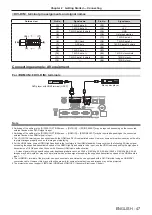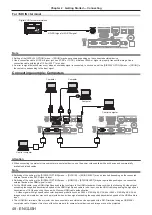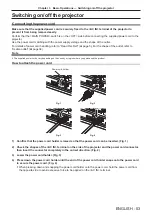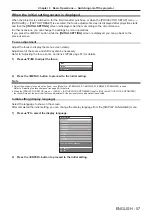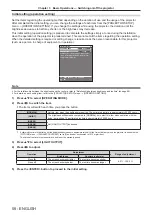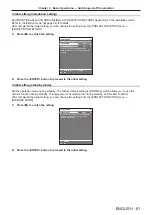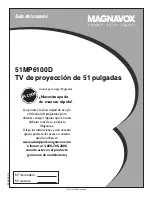
Chapter 2
Getting Started — Connecting
46 - ENGLISH
Connecting
Before connecting
f
Before connecting, carefully read the operating instructions for the external device to be connected.
f
Turn off the power of all devices before connecting cables.
f
Connect cables taking care of the following descriptions. Failure to do so may result in malfunctions.
g
When connecting a cable to a device connected to the projector or the projector itself, touch any nearby
metallic objects to eliminate static electricity from your body before performing work.
g
Do not use unnecessarily long cables to connect a device to the projector or to the projector body. The longer
the cable, the more susceptible to noise it becomes. Since using a cable while it is wound makes it act like an
antenna, it is more susceptible to noise.
g
When connecting cables, connect GND first, then insert the connecting terminal of the connecting device in a
straight manner.
f
Acquire any connection cable necessary to connect the external device to the system that is neither supplied
with the device nor available as an option.
f
If video signals from video equipment contain too much jitter, the images on the screen may wobble. In this
case, a time base corrector (TBC) must be connected.
f
If synchronization signals output from computers or video equipment are disrupted due to changes in the video
output setting or other reasons, colors of projected images may be temporarily disrupted.
f
The projector accepts YC
B
C
R
/YP
B
P
R
signals, analog RGB signals (synchronization signals are TTL level), and
digital signals.
f
Some computer models cannot be connected to the projector.
f
Use a cable compensator when you connect devices to the projector using long cables. Otherwise the projector
may not project the image properly.
f
For details of the types of video signals that can be used with the projector, refer to “List of compatible signals”
(
x
page 229).
<RGB IN> terminal pin assignments and signal names
Outside view
Pin No.
Signal name
Pin No.
Signal name
(10)
(6)
(11)
(15)
(1)
(5)
(1)
R/P
R
(9)
―
(2)
G/Y
(10)
GND
(3)
B/P
B
(11)
GND
(4)
―
(12)
DDC data
(5)
GND
(13)
SYNC/HD
(6)
GND
(14)
VD
(7)
GND
(15)
DDC clock
(8)
GND
<HDMI IN> terminal pin assignments and signal names
Outside view
Pin No.
Signal name
Pin No.
Signal name
Even-numbered pins of
(2)
to
(18)
(1)
(19)
(2)
(18)
Odd-numbered pins of
(1)
to
(19)
(1)
T.M.D.S data 2+
(11)
T.M.D.S clock shield
(2)
T.M.D.S data 2 shield
(12)
T.M.D.S clock
-
(3)
T.M.D.S data 2
-
(13)
CEC
(4)
T.M.D.S data 1+
(14)
―
(5)
T.M.D.S data 1 shield
(15)
SCL
(6)
T.M.D.S data 1
-
(16)
SDA
(7)
T.M.D.S data 0+
(17)
DDC/CEC
GND
(8)
T.M.D.S data 0 shield
(18)
+5 V
(9)
T.M.D.S data 0
-
(19)
Hot plug detection
(10)
T.M.D.S clock+
















